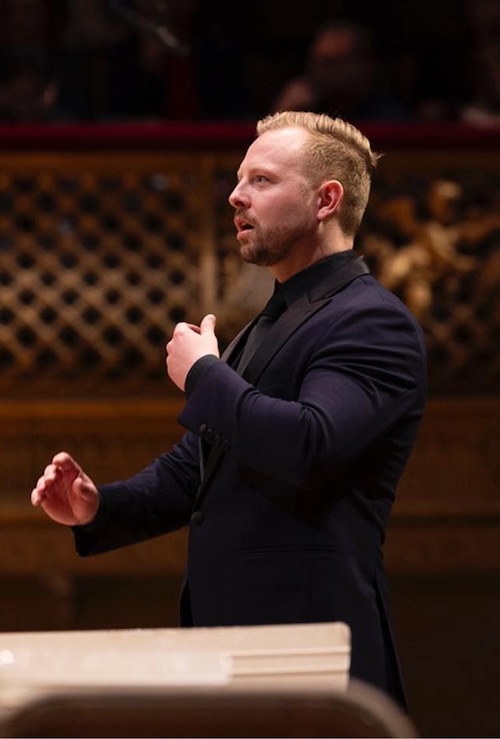Conductor Parsley impresses in Seraphim program that moves from darkness to light
Not everyone can portray something so abstract yet real such as the human experience.
Sunday at First Church in Cambridge, Seraphim accomplished this in a heartfelt program of sacred choral works featuring challenging repertoire spanning more than two centuries. Titled “Eternal Voices and Sacred Landscapes,” the program aimed to express the transition from darkness to light, from uncertainty and fear to serenity, peace, and sanctuary.
The program also reflected a transition in the organization as well. Daniel Parsley, led this program, the first of three candidates to succeed music director emerita Jennifer Lester.
The opening work, Britten’s A Hymn of St. Columba, set the tone for the afternoon, with Parsley and the ensemble displaying an innate sense of voicing tight intervals, suspensions, and other dissonances to grasp the tension before releasing them carefully.
Throughout the program, Parsley delivered special attention to the vocal acoustic and shape of lines, developing a musical experience rich with expression and color. Seraphim produced a pristine sound with a distinct core that filled even the silences between musical ideas.
Arvo Pärt’s Magnificat, written in his characteristic tintinnabuli style, divides the chorus into “effectively eight parts.” This vocal ensemble cruised through unnaturally leaping vocal writing of purer chords and melodic simplicity, generating an immersive effect that wove different parts together but presented tricky moments for tuning. The direction was more vertical than horizontal, which succeeds effectively in a piece like this. Upper voices sounded particularly crystalline as if evoking glass-harmonicas, with lower voices rounding out like a wider nebula in the galaxy.
This interplay was also evident in Trond Kverno’s Ave Maris Stella, with the addition of controlled accelerando, flowing rhythmic variety, and fine-tuned dynamic and melodic imitation among different parts.
Even in the reverberant hall, clear plosive consonants impressively cut through the lush texture of their clear harmonies. The first half of the program demonstrated masterful dynamic and expressive control.
With intentional shaping and time-taking to overlap multiple lines, the ensemble provided a sense of space within the music so critically demanded by the performance venue and occasion.
Less successful was Mendelssohn’s Verleih uns Frieden. While the German was clear, it lacked a horizontal line and inflection of the text to infuse meaning into the choral writing.
Emma Lou Diemer’s dance-like, upbeat organ solo Fiesta in the middle, masterfully played by Heinrich Christensen, was refreshing after the slower, more austere first half.
A clear shift was audible after this piece, both in terms of thematic programming and the vocal color adopted by the ensemble. There was an emphasis away from the purity of sound demonstrated in the first half, as if the ensemble had left the otherworldly quality in exchange for the present, human experience. In practice this meant the singers adopted a more forward-sounding resonance and softer diction, playing with the rhythmic waves ardently started with Fiesta.
Parsley joined the ranks of the singers in Alice Parker’s arrangement of “Hark, I Hear the Harps Eternal,” which made the experience more personal. This interpretation felt much more like a group of singers at a gathering rather than a rehearsed chamber chorus, perhaps keeping with the genre. The texture of the spiritual “I’m Gonna Sing ‘Til the Spirit Moves in My Heart” by Moses Hogan struggled to emerge from the space, but the spoken, bluesy part-singing and the brilliant flourish in the lines ended with dramatic, unexpectedly resonant hums.
Seraphim shined most in a cappella pieces like the opening Hymn and O Radiant Dawn by James MacMillan. Highlights included MacMillan’s Serenity, in which solo sopranos sang mysteriously from the stage right behind the semicircle; the alto solos provided drastically different colors in Imant Raminsh’s Kyrie.
Also notable was countertenor Kelvyn Koning’s invigorating musicality and tone in the final piece, Keith Hampton’s True Light, which guided an almost musical theater sound. It was a different sensibility, yet Seraphim soared in the unison lines and more straightforward harmonies, which, at the end of this challenging program, proved well-deserved.
Seraphim presents a Christmas program, “Light from Deepest Heaven” December 21 and 22. seraphimsingers.org
Lani Lee is a mezzo-soprano based in Cambridge and a mechanical engineering PhD candidate at MIT. She has performed as a soloist in performances by the MIT choirs and holds a minor in music as part of her undergraduate degree. In addition to solo work, she is an active member of the Tanglewood Festival Chorus.
Posted in Performances
